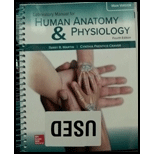
Laboratory Manual For Human Anatomy & Physiology
4th Edition
ISBN: 9781260159080
Author: Martin, Terry R., Prentice-craver, Cynthia
Publisher: Mcgraw-hill Education,
expand_more
expand_more
format_list_bulleted
Concept explainers
Question
Chapter 5, Problem 3.4A
Summary Introduction
To explain:
Interdependence of cell structure and function.
Introduction:
The cell is the smallest structural and functional unit of any living organism. Tissue is any of the distinct type of material of which animals or plants are made up of consisting of specialized cells and their products.
Expert Solution & Answer
Want to see the full answer?
Check out a sample textbook solution
Students have asked these similar questions
A scientist is studying a cell that has a membrane-bound nucleus and a cell wall but lacks chloroplasts. Which kind of cell is the scientist studying?
Use your imagination in creating a story to show the cell of the cell membrane. The characters of the story would be the different components of the cell membrane. Be Creative
A cell that is missing this structure would not be able to make rRNA or assemble ribosomes. Name the cell structure AND explain why. Then state which type of cell(s) have this structure.
Chapter 5 Solutions
Laboratory Manual For Human Anatomy & Physiology
Ch. 5 - Which of the following cellular structures is not...Ch. 5 - Which of the following cellular structures is...Ch. 5 - The outer boundary of a cell is the mitochondrial...Ch. 5 - Microtubules, intermediate filaments, and...Ch. 5 - Easily attainable living cells observed in this...Ch. 5 - A slide of human cheek cells can be stained to...Ch. 5 - Cellular energy is stored in ER. ATP. DNA. RNA.Ch. 5 - The smooth ER possesses ribosomes. True...Ch. 5 - The nuclear envelope contains nuclear pores. True...Ch. 5 - The cells lining the inside of the cheek are...
Ch. 5 - Figure 5.4 Label the indicated cellular structure...Ch. 5 - Match the cellular components in column A with the...Ch. 5 - Prob. 2.1ACh. 5 - Prob. 2.2ACh. 5 - What do the various types of cells in these...Ch. 5 - What are the main differences you observed among...Ch. 5 - Prob. 3.4ACh. 5 - Electron micrographs represent extremely thin...Ch. 5 - Electron micrographs represent extremely thin...Ch. 5 - Electron micrographs represent extremely thin...Ch. 5 - Electron micrographs represent extremely thin...Ch. 5 - Electron micrographs represent extremely thin...Ch. 5 - Electron micrographs represent extremely thin...Ch. 5 - Electron micrographs represent extremely thin...Ch. 5 - Electron micrographs represent extremely thin...Ch. 5 - Electron micrographs represent extremely thin...Ch. 5 - Electron micrographs represent extremely thin...
Knowledge Booster
Learn more about
Need a deep-dive on the concept behind this application? Look no further. Learn more about this topic, biology and related others by exploring similar questions and additional content below.Similar questions
- One way to understand cell function is to compare the parts of a cellto the parts of a factory. For example, the Golgi apparatus would beanalogous to the factory’s shipping department. How would the othercell parts fit into this analogy?arrow_forwardWhat is the function of a cell wall?Single choice. A. to protect and support the cell B. to perform different functions in each cell C. to prevent water from passing through itarrow_forwardWhich cell part helps control the matterials that enter and leave a cellarrow_forward
- Compare and contrast plant cell from animal cell.arrow_forwardCompare and contrast an animal cell from a plant cell by constructing a table of similarities and differences. Explain only in 1-3 sentencesarrow_forwardUse the analogy of the cell as a manufacturing factory to describe the function of the following cell structures: plasma membrane, mitochondria, nucleus, Golgi, ribosomes, lysosomes, endoplasmic reticulum.arrow_forward
- A student explains that plant cells have cell walls but not cell membranes, while animal cells have cell membranes but not cell walls. What is wrong with this statement?arrow_forwardAssume that you place a freshwater plant into a saltwater solution and examine it under a microscope. What happens to the plant cells? Draw and illustrate your explanation.arrow_forwardIdentify one component of the cell. Describe the structural appearance using your own words Explain the function of the structure. Show a relationship between your component and another structure that it can possibly work with Describe what would happen to the cell if your structure is missing or damaged.arrow_forward
- Which statement regarding types of cells is accurate? a The presence of internal membranes indicates the ability of a cell to become multicellular and thus more complicated b Prokaryotic cells are smaller and simpler than eukaryotic cells c Eukaryotic cells are larger and more complex than prokaryotic cells d All cells maintain differing internal and external environments, regardless of constructionarrow_forwardFor each item choose the letter of the best answer. No need to write the explanations. 37. How does a cell identify incoming or outgoing substances? A. Uses cell metabolic processes B. Uses cell transport system C. Uses cell recognition proteins D. Uses polarity of membrane to attract substances 41. Osmosis is considered a form of diffusion. Why? A. It depends on a concentration gradient. B. it requires a semipermeable membrane. C. It depends on a water potential gradient. D. It moves from a high to low area of concentration. 42. Which is NOT true about the factors that can affect the rate of diffusion? A. application of pressure increases the rate of diffusion B. higher temperature results in a faster rate of diffusion C. the solubility of the solute does not affect the rate of diffusion D. the higher the density of the solvent, the slower the rate of diffusion 45. Which of the following is NOT true about facilitated diffusion? A. requires energy B. requires a carrier protein C.…arrow_forwardWhich part of a cell is most like the cockpit of a plane? A. The cytoplasm B. The membrane C. The macromolecule D. The nucleusarrow_forward
arrow_back_ios
SEE MORE QUESTIONS
arrow_forward_ios
Recommended textbooks for you



